Special
Presentation III
|
MAY THE
"BIRD OF PARADISE..."
Sunday, 15 August 2010 was one
of those
days, one of those 'boring' days in Florida when the wind lays the ocean
down near
the Treasure Coast, and the sea is an aqua blue.
Bonnie
Schubert and her Mom, Jo, were back in the water after some heavy
maintenance
on their new salvage boat, "GOLD
HAWG" ... and then they found it!
|
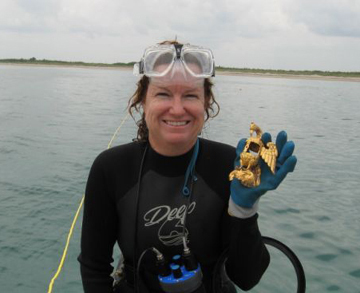
|

|
At first thought by most to be an eagle, and by
some a
turkey, the solid gold bird is preliminarily identified by Historian
Dr. Eugene
Lyon as a " Pelican in Piety"-- representing the legend of the
'mother pelican' wounding her breast to feed her young on the droplets
of her
own blood and used as a symbol of Christ's sacrifice.
Standing a stately 5-1/2 inches tall, the avian
relic
weighs 177 grams --that's without her right wing-- and she tests out at
22
karats of pure gold. In her heyday, her open torso held something,
probably
something ritualistic, possibly an incense container.
Through a hole in the center of
her base, she may have been mounted to a pole ... or to an altar. We'll
have to
wait for the jury to come in with all the details on this wondrous
piece.
|
|
The ornate base of this statuette, on which the
bird is
standing, resembles a turban and displays what could be a
'Fleur-de-Lis' on the
face of it.
+Update:
"Historic Note" below indicates the Base is a nest. Must be "feathered"
in the mind of the sculptor. 31 AUG 2010.
+Update: Margaret Weller has seen
painting or engraving with this (type) statuette mounted to a staff or
pole! (Incense burner?)
|

|
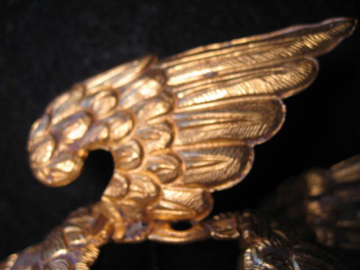
|
"It was just Mom and me aboard the 'Gold Hawg'
(C-11,
Harold’s old number – for luck!) – I still am in shock. Didn’t think we
were
even going to make it out there this year, what with engine rebuild and
etc."
"One wing is missing, and I have been out three
days
searching for it – no luck there and now our fingers are crossed that
we get in
a few more days ... but it looks like the tropics are firing up."
--Bonnie
and Jo, 25 AUG 2010.
◙
<<Push here for historic note on bird.
|
Special
Presentation II
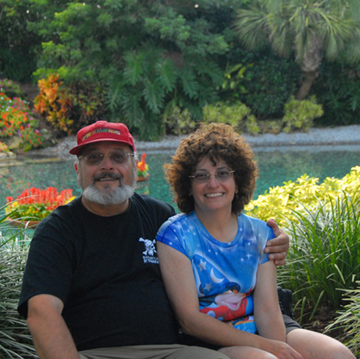
The Not-so-Successful
but Lots-of-Fun 2007 Sadwin Family Vero Beach
Treasure
Hunting Expedition
by Alan Sadwin
Alan
and Sandy Sadwin
live on Long Island, NY. They are avid beachcombers, defying the
elements at
times to sweep the south shore beaches near their home to find “buried
treasure.” We salvagers have a saying that they recently came to adhere
to: “No sense diving
where there ain’t no shipwreck!”
|
The
title of this article may give away the results of this
trip (no emeralds, gold doubloons, or pieces of eight), but read on to
hear
about the wonderful 4-1/2 days Sandy and I spent at Vero Beach,
Florida. After
all, metal detecting should be fun, even if you don’t always find
buried
treasure.
It has been a few years since Sandy
and I tried our hand at
metal detecting on Florida’s Treasure Coast, and we started planning
this trip
in January. Our “treasure map” was the excellent Shipwrecks Near Wabasso
Beach
book by Bob “Frogfoot” Weller and Ernie “Seascribe” Richards, which
lists 14
shipwrecks along the Treasure Coast. The book includes a brief history
of each
wreck and what treasure has been found, and it includes directions on
how to
find each wreck site. The directions include the distances to each
wreck from
Disney’s Vero Beach Resort, which happens to be where we were staying.
It is
required reading and daily reference for anybody planning a treasure
hunting
trip to Vero Beach.
We
had hoped to arrive just after a major storm when there
is a better chance for finding Spanish treasure. We managed to arrive
in
Florida just as Hurricane Noel was passing offshore on Thursday, 1
November and
drove down from Orlando through sporadic downpours. After checking in,
we
headed straight to the beach. Unfortunately, we could only take one
detector on
that first day, as some dummy (me) had managed to pack his detector
powered on
and had drained the battery.
|
|
We decided to start at the
Turtle Trail beach access which
is the site of the wreck of the Nuestra Señora de
la Regla, the capitana
of the 1715 Fleet and one of the galleons which held a large amount of
treasure. This is the location most people recommend for treasure
hunting when
in Vero, as gold, silver, and artifacts have all been found there. The
surf was
up and there was some erosion, but the locals who were checking out the
beach
when we arrived decided not to detect that day. One of the reasons is
that the
erosion was to sand that had been brought in to reclaim the beach after
a
hurricane passed through Vero a few years ago. We were told that the
original
beach was buried below 5 to 8 feet of new sand. The rain was torrential
at
times and we kept our DFX dry under a rain coat. The tide seemed to be
higher
than we expected, but we weren’t sure why. After 3-1/2 hours, we had
found one
quarter and called it a day.
Friday was sunny and the surf
and wind were still up.
According to the Salt Water Tides table I printed just before we left,
low tide
in Vero was about 1:00 PM so we slept until 7:00, ate breakfast and
headed to
the beach about 10:00 AM. It was a sunny day, but the surf remained
very high.
Our first stop Friday was just south of Sebastian Inlet and is a site
identified as the “Pines Wreck” by Kip Wagner, one of the original
Treasure
Coast hunters. We decided not to hunt this site as it is on the Archie
Carr
National Wildlife Refuge. While the locals claim that detecting is
allowed
there, we felt that it was too close to the end of the turtle hatching
season
(31 October) to take a chance. We had noted that some turtles were
still
hatching, as evidenced by broken egg shells.
We then moved
south to the Ambersands Parking
and Beach Access and detected to the north until just before the
McLarty
Treasure Museum.
|

"DISNEY-LAND BY
NIGHT"
The Disney Vero
Beach Resort at County Road 510 and U.S. Highway A1A. Its ocean
view covers the wreck sites of three ships: The "Admiral" of the
Honduran Fleet of 1618; a treasure-laden galleon of the 1715
Spanish silver fleet; and a British collier of 1825. Grab your
detector, and hit the beach! The resort is "Ground Zero" for directions
to the wrecks in our "best selling" book mentioned by the Sadwins.
|

WABASSO BEACH.
Looking north along the
cutaway dune this evening, you expect to find the surf full of
pieces-of-eight and other treasures when you swing your detector in the
morning...
|
On the way we passed Kip
Wagner’s cabin. Kip used to walk
this very beach and skip flat rocks across the water. He later
discovered that
those flat rocks were, in fact, Spanish pieces of eight, and the era of
treasure hunting in Florida began. I skipped a few rocks in Kip’s
honor, but
only after verifying that they weren’t Spanish silver. After 3-1/2
hours, we
called it a day. The tide was still much higher than we expected and,
in
talking to a fellow detectorist (not a local), we determined that the
tide
charts we were using were way off and that low tide was actually at
about 8:30
AM.
We then went shopping in Vero at
our favorite book store.
Unfortunately, we already had every treasure hunting book that they
stocked.
When we returned to the hotel, we used a hotel handout to confirm that
low tide
was in fact in the morning. That chart was also from Salt Water Tides.
We still
haven’t figured out why the drastic difference, but I am working the
issue.
|
|
Saturday, low tide was at 9:30
AM and we were sure to be on
the beach at 8:00 AM. It was easy because we just walked out of the
hotel and
onto the beach. The shipwreck of interest was the San
Martín, the almiranta
of the 1618 Honduran Fleet. 3-1/2 hours later we had a handful of
modern
change. Most coins were US clad coinage dated before 1994. There was
even one “wheatie.”
We did see a couple of detectorists who were not local. One was
carrying a
2-foot long piece of 4” x 4” wood that looked to have been underwater
for quite
a long time. Of even more interest was the polished copper or bronze
tack that
was attached to it. Personally, I suspect it was a piece of a shipwreck
and not
a recent one at that.
Saturday afternoon, we went to the Mel Fisher
Treasure
Museum in Sebastian, Florida, where we saw many artifacts from both the
1715
Fleet and the Atocha. We also saw an emerald from the
Muzo area of Columbia
that a beachcomer had found on March 15, 2007. It is 69.32 carats and
is a cube
about ¾ inch per side. This stone was found in an area between
the Treasure
Shores beach access and the Golden Sands beach access. Treasure Shores
is also
the site of the “Cannon Wreck.” We decided to try our luck there on
Sunday.
Saturday night we ate in Sebastian at a restaurant called Squid Lips.
Should
you go to Vero, try this place. The band on Saturday was excellent as
were the
sea scallops wrapped in Cajun bacon. |
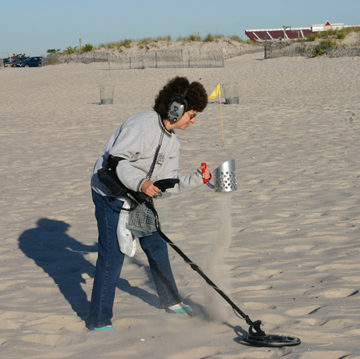
"Sandy"
Sadwin carefully investigates a "hit" from her detector on Wabasso
Beach, scoop by scoop so as not to miss a bit of treasure. She and Alan
get lots of time on their machines at local beaches on Long Island. You
know, where Captain Kidd used to hang out and is rumored to have buried
some swag!! But the Florida Treasure Coast was not in the mood to
release her treasures this day...
|
|
Sunday was our last day of metal
detecting and we made the
most of it. We were out 6 hours, but the result was the same. No gold,
silver,
or emeralds. We did meet a beachcomer who used to live in Freeport, NY.
He
showed us some fossilized shark teeth he had found on the beach and
gave Sandy
a few.
Monday the detectors were all cleaned and stowed,
but we
went back to Treasure Shores to try our luck at shark tooth hunting.
Finally
our luck changed and we each found a fossilized shark tooth. They had
to be
from a shark the size of a large minnow, but who cares? We actually
found
something.
We ended our Vero Beach visit
with a trip to the Pelican
Island National Wildlife Refuge, where we learned that most of the
wreck sites
that we detected north of the Disney Resort are, in fact, within the
boundaries
of the Archie Carr National Wildlife Refuge.
We are
already planning another visit, but may go in
March when the locals say the hunting is better. --Alan
|
Special
Presentation I

|
Part of the 1715 Salvage Fleet sits
at a dock in the Indian River in Ft. Pierce.
Foreground: "Royal Eight" ─
Captain Bonnie Schubert. Behind it, the "Endeavor."
All are shipshape and ready to go to work on the next favorable day...
|
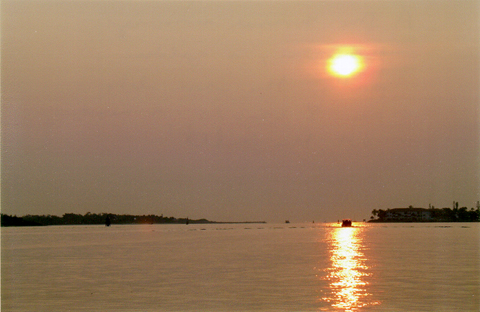
|
The first of the fleet departs
through the inlet this day...
Bonnie says, "A fine summer morning ─ flat calm, a golden path, the sun
like an 8 escudo & heading out the inlet!"
No excuse! Away all boats,
away!! |
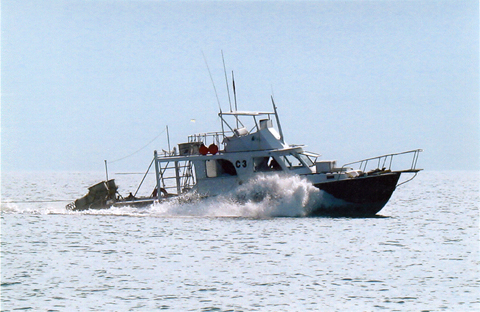
|
The "Endeavor" ─Captain John
Brandon─ cruises by, heading south to his "fishing hole."
Bonnie says, "Endeavor off to Douglass Beach. A very rare shot ─
we were up before John!"
|
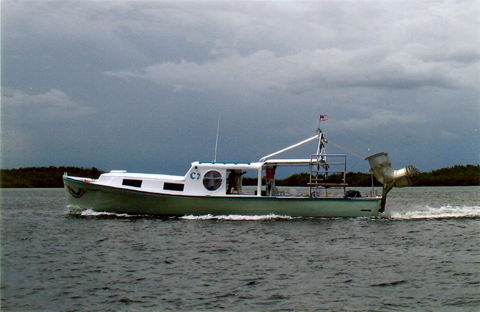
|
Later in the day, the "Virgalona" ─
Mike Perna Captain─ heads back to the docks through Ft. Pierce Inlet.
Recently sold by Mo Molinar, the "Virge" has been a real workhorse for
many seasons after moving here from years on the ATOCHA sites.
|
Bonnie Schubert is not a newcomer
to the Treasure Coast, but she is the new (recent) head of the "Royal
Eight" salvage operation here. Bonnie learned how to find and salvage
treasure the "right" way from veteran Harold Holden. Bonnie's mom, Jo,
was Harold's longtime companion, and Jo is now "crew" on Harold's
former boat and sites. Harold, Bonnie notes, "is still in good health
and his sister says he seems settled in and content" in his new life at
a retirement home. We all eventually have to throw out the anchor! The
"Royal Eight" recovered no treasure in 2007, but she's in great
condition and ... there's always next year. That's the old treasure
salvage spirit! PHOTOS by Bonnie
|
EN RADA Publications
P. O. Box 1698
West Palm Beach, FL
33402-1698
U.S.A.
e-mail Ernie Richards at:
SeaScribe@att.net

RETURN TO HOME
|
|
|